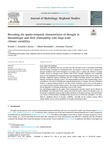| dc.contributor.author | Araneda-Cabrera, Ronnie J. | |
| dc.contributor.author | Bermúdez, María | |
| dc.contributor.author | Puertas, Jerónimo | |
| dc.date.accessioned | 2022-03-08T16:51:23Z | |
| dc.date.available | 2022-03-08T16:51:23Z | |
| dc.date.issued | 2021 | |
| dc.identifier.citation | Araneda-Cabrera, R. J., Bermudez, M., Puertas, J. (2021). Revealing the spatio-temporal characteristics of drought in Mozambique and their relationship with large-scale climate variability. Journal of Hydrology: Regional Studies, 38, 100938. | es_ES |
| dc.identifier.uri | http://hdl.handle.net/2183/29911 | |
| dc.description | Financiado para publicación en acceso aberto: Universidade da Coruña/CISUG | es_ES |
| dc.description.abstract | [Abstract:] Study region: Mozambique. Study focus: Mozambique does not currently have the necessary tools for systematic monitoring and forecasting of drought at a subnational scale. The purpose of this study was to characterize drought conditions and trends throughout the country and to evaluate the influence of major climatic drivers on drought events (period 1950–2019). Drought conditions were studied by means of the Standardized Precipitation and Evapotranspiration Index (SPEI) and run theory. The principal component analysis technique and the k-means clustering method were applied for defining homogenous drought regions. The Mann-Kendall trend test and Rescaled Range statistical analysis were used for defining the temporal characteristics of drought. The cross-correlation method, a spectral analysis based on the Fast Fourier Transform and a cross-wavelet analysis, were used to identify possible climate drivers. The results are ultimately intended to contribute to the development of a drought monitoring system in this country. New hydrological insights for the region: Three homogeneous drought regions can be defined in Mozambique. The South and Centre regions showed more intense and severe drought events. In all regions, a significant trend towards a higher incidence of droughts and long-term a persistence were found. El Niño-Southern Oscillation and Darwin Sea Level Pressure anomalies were identified as significant drivers of drought variability, especially in the southern regions. These climate indices can be used as predictors in drought forecasting models. | es_ES |
| dc.description.sponsorship | Xunta de Galicia; ED481A-2018/162 | es_ES |
| dc.language.iso | eng | es_ES |
| dc.publisher | Elsevier | es_ES |
| dc.relation | info:eu-repo/grantAgreement/EC/H2020/754446 | es_ES |
| dc.relation.uri | https://doi.org/10.1016/j.ejrh.2021.100938 | es_ES |
| dc.rights | Atribución-NoComercial-SinDerivadas 3.0 España | es_ES |
| dc.rights.uri | http://creativecommons.org/licenses/by-nc-nd/3.0/es/ | * |
| dc.subject | Drought | es_ES |
| dc.subject | Standardized Precipitation and Evapotranspiration Index (SPEI) | es_ES |
| dc.subject | Regionalization | es_ES |
| dc.subject | Trend | es_ES |
| dc.subject | Persistence | es_ES |
| dc.subject | Teleconnections | es_ES |
| dc.subject | Climatic indices | es_ES |
| dc.title | Revealing the spatio-temporal characteristics of drought in Mozambique and their relationship with large-scale climate variability | es_ES |
| dc.type | info:eu-repo/semantics/article | es_ES |
| dc.rights.access | info:eu-repo/semantics/openAccess | es_ES |
| UDC.journalTitle | Journal of Hydrology: Regional Studies | es_ES |
| UDC.volume | 38 | es_ES |
| UDC.startPage | 100938 | es_ES |
| dc.identifier.doi | 10.1016/j.ejrh.2021.100938 | |






